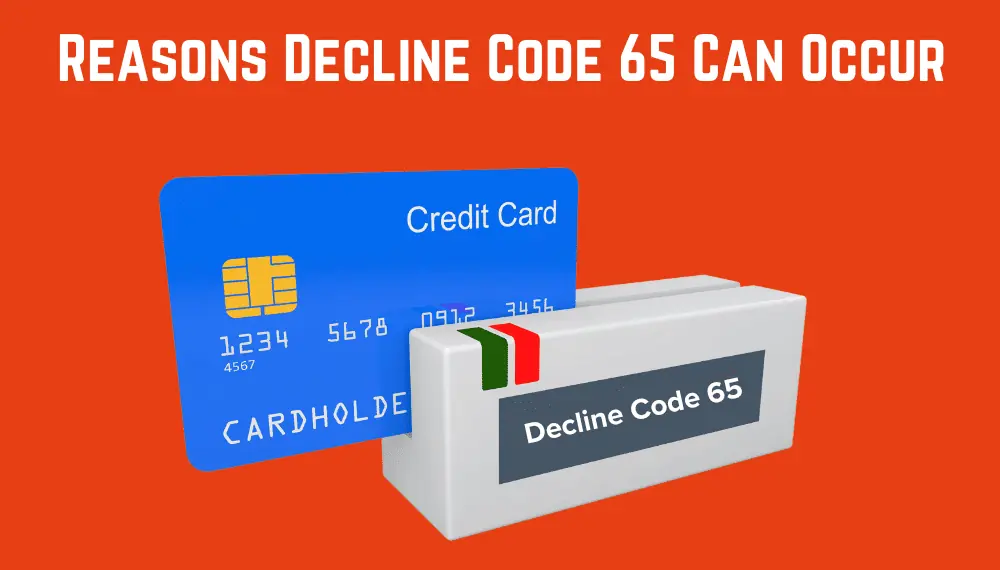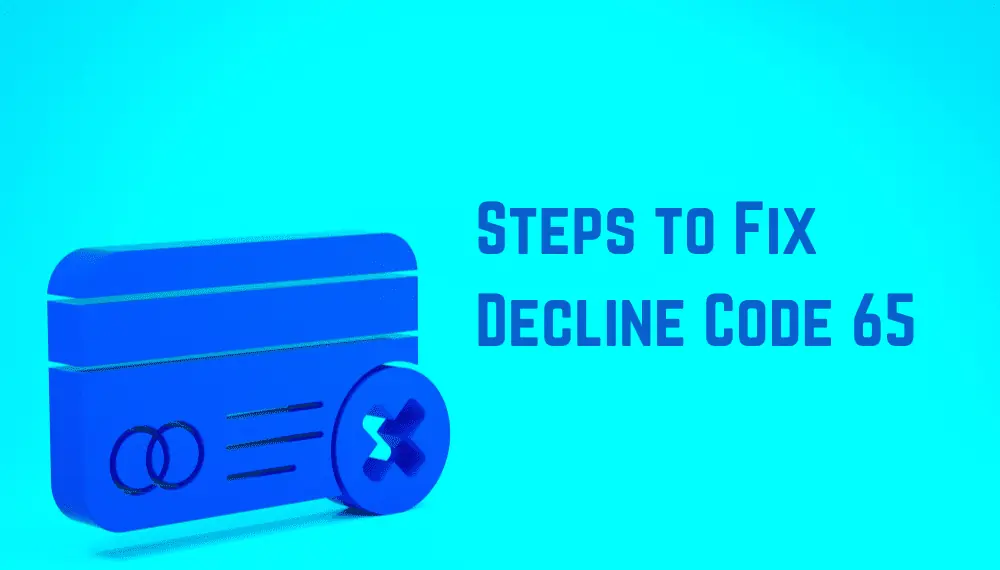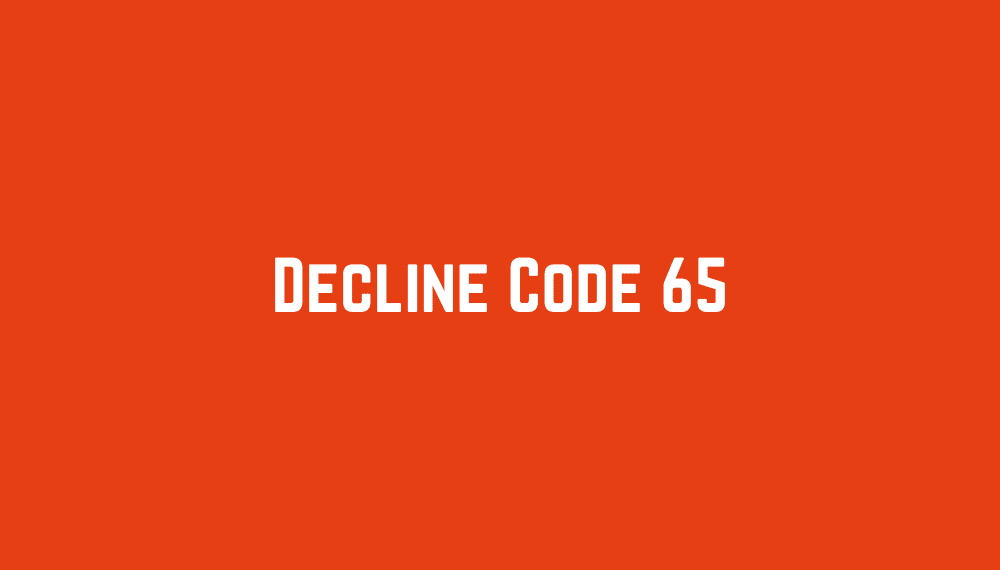The number in the decline code is important. Merchants come across many types of decline codes while accepting debit or credit cards. The number in the decline code explains the reason for the decline. One of the most important decline codes is decline code 65.
The number 65 is crucial. Each number that appears with a decline code denotes a specific reason or an issue. Decline code 65 means the decline to approve a transaction by the bank while processing the payment. The bank might decline the transaction for various reasons. This includes cards on hold due to fraudulent transactions. Or, it might occur due to a technical reason.
To resolve issues with the customer you should first understand each and every decline code including decline code 65. Read below the reasons why you receive decline code 65 and how to resolve it.
What Does Decline Code 65 Mean?
Decline Code 65, encountered during credit card processing, carries a significant message for both merchants and customers alike. This code serves as an indicator that the cardholder has surpassed their credit limit, leading to the decline of the transaction.
Alternatively, it may signify that the individual has reached the maximum allowable number of transactions within a specific time frame. It is crucial for merchants to know the difference between Decline Code 65 and Code 51, which denotes insufficient funds on the card. Both of these relate to distinct issues with the cardholder’s credit.
When faced with a Decline Code 65, customers must take immediate action to rectify their credit situation or manage their spending to avoid future inconveniences. For businesses, understanding this code ensures they can communicate effectively with customers about declined transactions, fostering trust and providing clarity.
![]() Recommended – Read about all types of decline codes
Recommended – Read about all types of decline codes
Reasons Decline Code 65 Can Occur

Decline Code 65 is a crucial message that payment processors relay to merchants when a credit card transaction is declined due to the cardholder exceeding their credit limit or reaching the maximum permitted number of transactions within a specified period.
Several factors can lead to this occurrence, and understanding these reasons is essential for both merchants and customers to ensure seamless and secure payment processing.
Reasons for Decline Code 65
1- Credit Limit Exceeded
The most common reason for a Decline Code 65 is when the cardholder surpasses their credit limit. A credit limit is the maximum amount of money a cardholder can borrow from the credit card issuer. When making a purchase that exceeds the available credit on the card, the transaction will be declined, and the system will generate Decline Code 65 to communicate this limitation.
2- High Outstanding Balances
Even if the cardholder has not reached their credit limit, having a substantial outstanding balance on their credit card can still lead to a Decline Code 65. Credit card issuers may implement internal risk assessments and limit the number of transactions or the total amount that can be charged on the card if the cardholder carries a significant debt.
3- Multiple Pending Transactions
If the cardholder has several pending transactions yet to be fully processed, it can also trigger a Decline Code 65. The card’s available credit is reduced by the amount of pending transactions, and if it goes below the necessary limit for the new purchase, the transaction will be declined.
4- Low Credit Score
A cardholder’s credit score plays a vital role in determining their creditworthiness. If the credit score has dropped significantly since the card was issued, the credit card issuer may reduce the credit limit, leading to potential Decline Code 65 situations.
5- Temporary Holds and Authorizations
Merchants often place temporary holds or authorizations on credit cards to ensure sufficient funds for pending purchases. While these are not actual charges, they can temporarily reduce the available credit on the card, making it more prone to Decline Code 65 if the credit limit is almost reached.
6- Cardholder’s Delinquency
If the cardholder has a history of late payments or has defaulted on credit obligations, the credit card issuer may lower the credit limit or restrict further transactions, leading to Decline Code 65 occurrences.
7- Fraudulent Activity Concerns
In some cases, the credit card issuer might detect suspicious or potentially fraudulent activity on the card, prompting them to block transactions temporarily and generate Decline Code 65. This security measure aims to protect the cardholder from unauthorized transactions.
For merchants, understanding these reasons helps in communicating with customers effectively, providing support, and ensuring a smoother payment processing experience for all parties involved. Additionally, implementing robust fraud detection and prevention measures can further reduce the likelihood of encountering Decline Code 65 due to suspicious activities.
Steps to Fix Decline Code 65

Fixing Decline Code 65 requires prompt action and cooperation between the cardholder and the credit card issuer. Here are the steps to resolve the issue:
- Check Available Credit
As a cardholder, the first step is to check your available credit. Access your credit card account online or contact the credit card issuer’s customer service to inquire about your current credit limit and outstanding balance. Make sure you have enough available credit to complete the transaction you intend to make.
- Pay Down Outstanding Balances
If you have a high outstanding balance on your credit card, consider making a payment to reduce it. Lowering your balance will free up more available credit, potentially resolving the Decline Code 65 issue.
- Confirm Pending Transactions
Verify if there are any pending transactions that have not been fully processed yet. These pending transactions can temporarily reduce your available credit. If any are no longer necessary, contact the merchant to cancel them or wait until they are completed to regain the available credit.
- Contact the Credit Card Issuer
If you believe the Decline Code 65 is due to an error or if you are unsure of the reason, contact the credit card issuer’s customer service. They can provide specific information about the decline and help you understand the situation better. Sometimes, the decline could be a result of fraudulent activity, and reporting it promptly can help protect your account.
- Request a Credit Limit Increase
If your credit card usage has been responsible and you have a good credit history, consider requesting a credit limit increase from your credit card issuer. A higher credit limit will provide more flexibility and reduce the chances of encountering Decline Code 65 in the future.
- Review Your Credit Report
Obtain a copy of your credit report and review it for any inaccuracies or potential issues that might have contributed to the decline. If you find any errors, report them to the relevant credit bureau to have them corrected.
- Budget and Spend Wisely
To prevent future occurrences of Decline Code 65, create a budget and spend within your means. Avoid maxing out your credit card or making multiple large transactions in a short period. Responsible credit card usage will help maintain a healthy credit profile.
- Be Mindful of Temporary Holds
Understand that merchants may place temporary holds or authorizations on your credit card for certain transactions. These can temporarily reduce your available credit, so be mindful of them while making other purchases.
- Monitor Your Account Regularly
Keep a close eye on your credit card account and transactions regularly. Set up account notifications to receive alerts for any unusual activity which could indicate potential fraud or security issues.
By following these steps and proactively managing your credit card usage, you can effectively address and prevent Decline Code 65 occurrences, ensuring smoother and more successful transactions in the future.
How Can Businesses Deal with Decline Code 65

Dealing with Decline Code 65 is essential for businesses to ensure smooth payment processing and maintain positive customer relationships. Here are some steps that businesses can take to address and manage Decline Code 65 effectively:
Display Clear Payment Messages
During the checkout process, provide clear and concise messages to customers about declined transactions. Instead of just showing “Transaction Declined,” include a brief explanation, such as “Decline Code 65: Credit Limit Exceeded” or “Decline Code 65: Maximum Transactions Reached.” Clear messages help customers understand the reason for the decline and may prompt them to take necessary actions to resolve the issue.
Offer Alternative Payment Options
In cases where a customer’s credit limit has been reached or exceeded, provide alternative payment methods at the checkout. Options such as debit cards, PayPal, or other digital wallets can give customers flexibility in completing their purchases.
Encourage Communication
Include contact information for customer support on your website and in transaction decline messages. Encourage customers to reach out if they encounter any issues during the payment process. Responsive customer support can help resolve individual cases and address customer concerns promptly.
Suggest Split Payments
If a customer’s credit limit is close to being reached, offer the option to split the payment across multiple transactions. This way, the customer can complete the purchase without exceeding their credit limit.
Implement Real-time Transaction Monitoring
Use fraud detection and prevention systems that can identify suspicious activities and potential instances of Decline Code 65 in real time. Such systems can help protect both the business and customers from fraudulent transactions.
Monitor Cardholder Behavior
Keep an eye on customers’ transaction history and behavior. Frequent declines due to Decline Code 65 could indicate credit management issues or potential fraudulent activity. Monitoring these patterns can help businesses make informed decisions and identify high-risk transactions.
Educate Customers
Provide resources on your website or through customer emails to educate users about credit card usage, credit limits, and managing their credit wisely. Informing customers about these aspects can reduce the likelihood of encountering Decline Code 65 due to inadvertent credit limit breaches.
Work with Payment Processors
Collaborate with your payment processing partner to understand the specific reasons for Decline Code 65 occurrences. The payment processor may be able to provide insights into the decline patterns, enabling businesses to adjust their strategies accordingly.
Periodic Reviews and Adjustments
Regularly review and analyze your decline data to identify trends and patterns. Use this information to make informed decisions about pricing, transaction limits, or credit risk management strategies.
By implementing these strategies, businesses can minimize the impact of Decline Code 65 on their operations, enhance customer experience, and optimize their payment processing procedures. It is essential to strike a balance between preventing fraudulent transactions and ensuring that legitimate customers can complete their purchases smoothly.
Conclusion
In conclusion, understanding and effectively managing Decline Code 65 is crucial for both customers and businesses in the realm of payment processing. For cardholders, keeping track of credit limits, managing outstanding balances, and maintaining a healthy credit score are essential steps to avoid encountering this code.
On the other hand, businesses can enhance customer experiences by providing clear payment messages, offering alternative payment options, and encouraging open communication with their support teams. Employing real-time transaction monitoring, fraud detection systems, and educating customers about credit card usage also play pivotal roles in mitigating Decline Code 65 occurrences.
By proactively addressing these issues, businesses can build trust with their customers, optimize payment processing procedures, and ensure seamless transactions that contribute to overall satisfaction and success in the marketplace.
Frequently Asked Questions (FAQs)
Why did my credit card get declined with Decline Code 65?
Your credit card may get declined with Decline Code 65 if you have exceeded your credit limit, have a high outstanding balance, or have pending transactions that have not been fully processed yet. It can also occur if your credit score has dropped significantly, leading the credit card issuer to restrict further transactions.
Can I still use my credit card after encountering Decline Code 65?
If you encounter Decline Code 65, your credit card will be temporarily blocked for further transactions until the issue is resolved. Once you address the reason for the decline, such as paying down balances or contacting customer service, you should be able to use your credit card again.
Can a merchant override Decline Code 65?
Merchants cannot directly override Decline Code 65 as it is a decision made by the credit card issuer based on the cardholder's credit limit and transaction history. However, merchants can offer alternative payment options to customers or suggest splitting payments to complete the purchase.
Does Decline Code 65 mean my credit card is blocked?
Decline Code 65 does not necessarily mean your credit card is permanently blocked. It indicates a temporary restriction on further transactions due to credit limit or usage issues. Once the underlying cause is addressed, the block will be lifted.
Can fraudulent activity trigger Decline Code 65?
Yes, fraudulent activity or suspicious transactions can trigger Decline Code 65. Credit card issuers use fraud detection systems to monitor for unusual patterns and may block transactions to protect cardholders from potential fraud.
Are there different Decline Codes for other reasons?
Yes, there are various Decline Codes used in payment processing, each indicating different reasons for transaction declines. These codes can include insufficient funds (Code 51), expired card (Code 54), and invalid card number (Code 14), among others.
Can Decline Code 65 impact my credit score?
Encountering Decline Code 65 itself does not directly impact your credit score. However, consistently exceeding your credit limit or having a high number of declined transactions may affect your credit score over time, especially if it reflects poor credit management.

